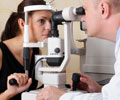An international team of researchers has made a breakthrough in study of childhood cataracts by discovering a new gene that is responsible for the condition.
An international team of researchers has made a breakthrough in study of childhood cataracts by discovering a new gene that is responsible for the condition.
The researchers were able to identify the location and defect in the coding region of the gene by the analysis of genetic material (DNA) from members of a large Swiss family, the majority of whom suffered from autosomal dominant juvenile cataract.It was also found that the corresponding protein belonged to a family of monocarboxylate transporters which move small molecules across cell membranes. In fact, this genetic defect may also lead to the condition of renal glucosuria, a non-pathological kidney defect with elevated levels of glucose in the urine, but not in blood.
The researchers have now started searching for the molecule that is carried by this new transporter across the membrane. It is suspected that this genetic defect hamper homeostasis in the lens as well as in the kidney.
As the known environmental risk factors for age-related cataract indicate physiological and oxidative damages building up over time within the lens, it is assumed that defects in this newly discovered transporter may also be a cause of age-related cataract.
Now age-related cataract patients are being screened to find mutations in this gene. New venues for non-surgical treatment of cataract may open by understanding the exact function of this transporter.
Cataract, the condition of altered refractive index in the lens of the eye, is the clouding of the eye’s normally clear lens and results in blurry vision that frequently includes disturbing glare in the visual field. Currently it can be successfully treated by surgical removal of the affected lens and replacement with an artificial one.
Advertisement
Identification of several genes that play an important role in structural or regulatory functions in lens cells has been made possible by research in molecular and genetic science.
Advertisement
Source-ANI
SRM/L










